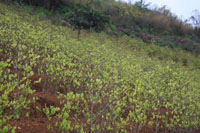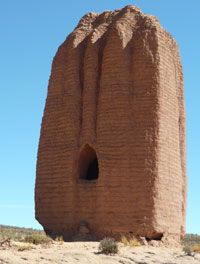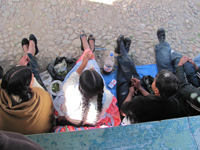 Coca is a plant native to South America that plays an important role in Andean societies. In addition to its medicinal value (stimulant, anesthetic, appetite suppressant), it has a leading role in social interaction and religious ceremonies.
Coca is a plant native to South America that plays an important role in Andean societies. In addition to its medicinal value (stimulant, anesthetic, appetite suppressant), it has a leading role in social interaction and religious ceremonies.
Unfortunately, the "sacred leaf" began to be used for other purposes at the beginning of the 20th century. Since then, it has become the raw material for cocaine production. The plant is one of the main reasons for the deterioration of the relationship between Bolivia and the United States, since the US proposed eradication of the coca leaf with the help of Bolivian governments prior to those of Evo Morales.
 On the one hand, Bolivia defends coca production using the argument that "coca is not cocaine." On the other hand, the US government considers it a threat to its own society, with good reason if you take into account that US consumption represents 50% of worldwide cocaine use.
On the one hand, Bolivia defends coca production using the argument that "coca is not cocaine." On the other hand, the US government considers it a threat to its own society, with good reason if you take into account that US consumption represents 50% of worldwide cocaine use.
Coca is a plant whose historic significance dates from pre-colonial times. It is believed that its use encompassed the entire Andes during the Tiwanaku empire and later the Inca empire. The oldest coca leaf was found on the northern coast of Peru dating from 2500 BCE.
There is evidence that coca was the most widely used plant from prehistoric times in the Andes until today in what are now Colombia, Ecuador, Peru, Bolivia, Chile, Argentina, Paraguay and Brazil.
Chewing coca, acullico as they say, is a very common practice in South America. It is done by picking the leaf and putting it between the cheek and jaw along with sodium bicarbonate. The mixture of the three elements of coca leaf, saliva and bicarbonate shapes a ball that includes alkaloids and some nutrients.
It is believed that during the colonial period the Spaniards imposed this practice in order to increase productivity in the mines and reduce their food costs.
Today the coca leaf is the symbol of indigenous people's justification. It could be said that coca is the backbone of Andean societies.
There are three types of relationships between Andean people and the coca leaf:
Economic
The coca leaf is used as currency in some communities. It is also cultivated to obtain returns and respond to new urban demands.
Social
 The coca leaf plays a fundamental role in the dynamic of social interchange in terms of reciprocity in Andean cultures. Likewise, coca is very important when a leader assumes his position in the community. Asking a woman's hand in marriage involves a handful of coca leaves as a gift. Coca is passed around and chewed at social get togethers. When a couple gets married, they build a house and plant coca. Daily work in the Andes includes four breaks for chewing coca.
The coca leaf plays a fundamental role in the dynamic of social interchange in terms of reciprocity in Andean cultures. Likewise, coca is very important when a leader assumes his position in the community. Asking a woman's hand in marriage involves a handful of coca leaves as a gift. Coca is passed around and chewed at social get togethers. When a couple gets married, they build a house and plant coca. Daily work in the Andes includes four breaks for chewing coca.
Magic
The coca leaf is used in religious rites for various purposes: to protect someone from curses and bad energy, to change bad luck, to predict the future and to make offerings to the Pachamama (Mother Earth).
More information: Coca Museum in La Paz


